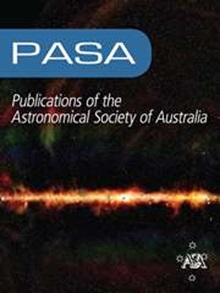九头蛇II:爱琴海,凯撒,深远,PyBDSF和塞拉维源发现者的特征
IF 4.6
3区 物理与天体物理
Q1 ASTRONOMY & ASTROPHYSICS
Publications of the Astronomical Society of Australia
Pub Date : 2023-04-27
DOI:10.1017/pasa.2023.29
引用次数: 1
摘要
摘要:本文采用一种名为Hydra的新软件工具,对几种源查找器(SFs)的性能进行了比较。论文1介绍了Hydra工具,并使用模拟数据演示了其性能。在这里,我们通过分析从宇宙演化图(EMU)试点调查中获得的真实观测数据,应用Hydra来评估不同源探测器的性能。EMU是一种宽视场无线电连续测量,其主要目标是对+30°赤纬以南的整个天空进行深度($20\mu$ Jy/波束RMS噪声),中等角度分辨率($15^{\prime\prime}$), 1 GHz测量,并期望检测和编目多达4000万个源。在主要的EMU调查中,非常需要了解无线电图像SF软件的性能,并确定优化源检测能力的方法。Hydra的开发是为了改进这一过程,并提供一系列指标和来自多个sf的源查找数据产品。我们从完整性和可靠性统计、通量密度和源尺寸测量等方面介绍了这里测试的五种SFs的性能,并对案例研究进行了探索,以突出发现者特定的局限性。本文章由计算机程序翻译,如有差异,请以英文原文为准。
Hydra II: Characterisation of Aegean, Caesar, ProFound, PyBDSF, and Selavy source finders
Abstract We present a comparison between the performance of a selection of source finders (SFs) using a new software tool called Hydra. The companion paper, Paper I, introduced the Hydra tool and demonstrated its performance using simulated data. Here we apply Hydra to assess the performance of different source finders by analysing real observational data taken from the Evolutionary Map of the Universe (EMU) Pilot Survey. EMU is a wide-field radio continuum survey whose primary goal is to make a deep (
$20\mu$
Jy/beam RMS noise), intermediate angular resolution (
$15^{\prime\prime}$
), 1 GHz survey of the entire sky south of
$+30^{\circ}$
declination, and expecting to detect and catalogue up to 40 million sources. With the main EMU survey it is highly desirable to understand the performance of radio image SF software and to identify an approach that optimises source detection capabilities. Hydra has been developed to refine this process, as well as to deliver a range of metrics and source finding data products from multiple SFs. We present the performance of the five SFs tested here in terms of their completeness and reliability statistics, their flux density and source size measurements, and an exploration of case studies to highlight finder-specific limitations.
求助全文
通过发布文献求助,成功后即可免费获取论文全文。
去求助
来源期刊
CiteScore
5.90
自引率
9.50%
发文量
41
审稿时长
>12 weeks
期刊介绍:
Publications of the Astronomical Society of Australia (PASA) publishes new and significant research in astronomy and astrophysics. PASA covers a wide range of topics within astronomy, including multi-wavelength observations, theoretical modelling, computational astronomy and visualisation. PASA also maintains its heritage of publishing results on southern hemisphere astronomy and on astronomy with Australian facilities.
PASA publishes research papers, review papers and special series on topical issues, making use of expert international reviewers and an experienced Editorial Board. As an electronic-only journal, PASA publishes paper by paper, ensuring a rapid publication rate. There are no page charges. PASA''s Editorial Board approve a certain number of papers per year to be published Open Access without a publication fee.

 求助内容:
求助内容: 应助结果提醒方式:
应助结果提醒方式:


